
O JUN Solo Exhibition : MANMANCHAN AN
10:00am-6:00pm, April 16 — July 3, 2016/ admission free
air2016-1en
O JUN
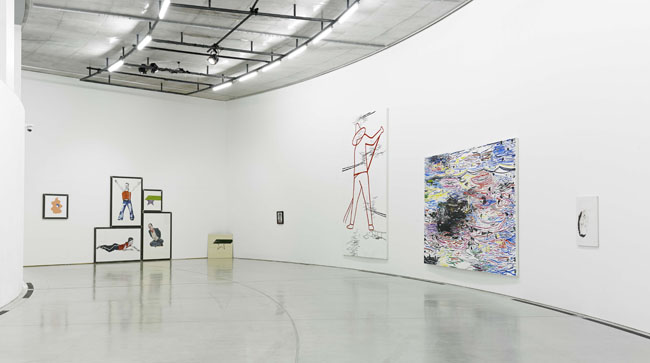
photo: YAMAMOTO Tadasu
Coming and Going: O JUN Solo Exhibition “MANMANCHAN AN”
KONDO Yuki
The characters, landscapes, and ordinary objects often portrayed in O JUN’s paintings can be ordinary to the point of discomfort. His motifs are at times discernable, but at others times can be seen as clusters of lines and colors, abstracted by different angles and techniques. O JUN hurls his subjects into absence, removing them from any background or context. He does this without modeling and using flat colors without shading, the undisguised touch of his brushstrokes, as well as simplified and symbolized subjects and a striking white space that isolates them. Convergent lines that would bring together a piece’s image and name—or image and meaning—never meet in O JUN’s work, as if they are avoiding what their union might bring. This causes uneasiness when trying to put a finger on what the subject matter of his work might be. Shapes, lines, images, and colors all flicker before our eyes with equal intensity, and cause our line of sight to jump back and forth between the rendered image and the materials used to create it. Perhaps it is also because the image itself appears in the valley between the coincidental and the inevitable, drawn as something that occurs just before the creation of meaning.
MANMANCHAN AN is comprised of oil paintings done by O JUN between 2003 and 2015, recent crayon pictures including two new ones created for this exhibition, as well as a number of pieces from YUEN (Playground), his ongoing series begun in 2006 that features his signature iron-framed artworks.
The exhibition’s title comes from baby talk that is used in Osaka and other areas of Western Japan when placing one’s hands together, such as before a meal, before a gravestone, or when reciting a prayer to the Buddha. It is described as coming from the Namu Amida Butsu chant, but O JUN says he remembers first hearing it as an Osaka comedian’s catchphrase when he was a child. It’s possible that the phrase has remained an unclassified yet vivid one for O JUN, connected to a unique personal memory precisely because it was heard and remembered without an understanding of its meaning. For that reason, the word would return to him unexpectedly when preparing for this exhibition.
These strange relationships between memory and certain words and images are often found in O JUN’s work. Events seen and heard by chance. Someone’s offhand remarks. Works related to these things often come up when asking O JUN about the background and inspiration for his paintings. Those experiences, internalized through his unique interpretation, are rendered abstractly, pruned of their original context and even the meaning he first gave them. Even the comedian catchphrase-turned-exhibition title is used as a phrase that accompanies ceremonial action, dissolving into daily life while dismantling its original meaning and origin. The phrase evokes the process of construction and deconstruction of images in O JUN’s work. His images seem to have been flung into space, suspended without a conceivable destination, but he doesn’t do this to intentionally mislead or disorient the audience. In an interview, O JUN said, “I think if I was conscious of composition or structure, my paintings probably wouldn’t be any good...The idea of just drawing...and ending up with a subject or image strangely suspended in space or stuck to the canvas as if its life depends on it—that, to me, is still better.”[1] But that isn’t to say that he draws his subjects according to conventions of structure and composition. Rather, it could mean that he perceives a corporeal image made by connections between memory and physical sensations through some sort of inevitability. The events connected by coincidence and inevitability in his creative process and the forms of his work are drawn clearly in white space as images that evade resolution.
In the exhibition, oil paintings from different eras adorned the gallery’s outer walls in a single straight line, situated without story or context. Perhaps there was some kind of internal connection for the artist, but it was not visible on the surface. Compared to Playground, which is bordered with the same iron frames, these oil paintings on canvas have a distinct texture and each is juxtaposed with the others while resolved within itself at the same time, each within its own world. Their juxtaposition generates strange spaces that blur the relationships between the artwork and their individual worlds. Their unreached conclusions and the tension within their images create a certain rhythm.
If this situation is generated by the combination of finished artworks, then the picture on the inner wall can be interpreted as a place to generate the images themselves. O JUNE often uses alloy pencils in his performances, on the basic premise that drawing is a form of doodling. From this, we can surmise that he did not intend to produce a specific, premeditated image on the ACAC gallery’s inner wall. The limp, twisted lines doodled along the wall assumed the shape of swirling poop. These winding lines connected back to the artist’s early memories of Iroha-zaka hill, a place mentioned by a childhood classmate—a beautiful boy but a big bragger. [2] The poop drawn on the wall sprouted faces, arms, and legs. Ultimately, a swarm of poopheads appeared in true doodled form, donning a variety of clothing and performing different acts. The protagonist here may have been the shape of these lines and the tenuous connection they create with the memories and images derived from their twists and turns. The shapes from O JUN’s pictures eventually formed the basis for Profile, a portrait of a poophead painted in crayon and fitted inside an iron frame.
O JUN’s crayon works were shown both in their iron frames and outside of them during his exhibition at void+ in Tokyo, held simultaneously with his exhibition at the ACAC. The works, completely settled within their iron frames, were stripped of their texture and gained intensity as nonphysical images. Their unframed counterparts, on the other hand, were like beasts stripped of their fur, exposed and vulnerable. The reality of the materials that form them—the texture of the paper and crayon—was ever present. This contrast seemed to swing back and forth between reality and fiction. In contrast, the poophead pictures and Profile, both created at the ACAC, conjured up the creative process of the image created by the artist’s hands and the inner workings of his mind.
His pictures were collectively given the title KUSOSEKAI (World of Shit). At a workshop held in the middle of the exhibition, his artwork was violently overwritten, destroyed by doodling participants who used the same alloy pencils that he made to create his pictures. Use of the same pencils made it harder to discern O JUN’s lines from those of workshop participants and, as a result, any hierarchy of good versus bad, high and low, was lost. The title of this work gains new meaning when we understand that O JUN does not give preferential treatment to the lines that are encapsulated as images, but rather sees them as impulsive traces spawned from bodily movement. We understand the ambiguity of O JUN’s childhood classmate and the impartiality of obscenity when we see the homogeneous nature of the lines. The proliferation of impulsive lines indicated similarities and dissimilarities between O JUN’s act of drawing and his paintings on the wall opposite, all arranged in a perfectly straight line. To O JUN, the act of drawing is an instinctual and even euphoric impulse. It is human nature removed from the intellectual, aesthetic, and strategic decisions within a work of art. And this primordial passion for the act can be just as valuable as the novel surprises depicted within fictional worlds, which retain scant glimpses of the acts of their creation. This contrast was poignantly highlighted and embodied in O JUN’s exhibition.
[1] Public interview with O JUN at exhibition opening, April 13, 2016 (at the ACAC)
[2] JUN, O. World of Shit, 2016 (see pp.06-07).
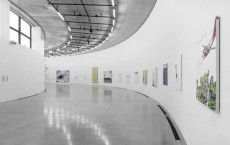


"profile"
crayon,color pencil onpaper, glass,iron
75×75×5cm,2016
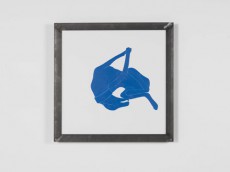
"Dog"
crayon,color pencil onpaper, glass,iron
75×75×5cm,2016

"KATARUCO"
paper,pigment,gouache,glass,iron
171×119×5cm,2007
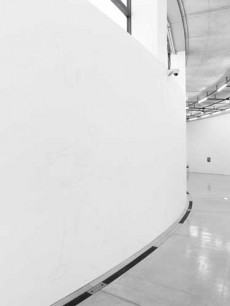
"KUSOSEKAI"
handmade alloy pen
on the wall,2016

O JUN 展 まんまんちゃん、あん
2016年4月16日(土)~7月3日(日)10:00-18:00 会期中無休・入場無料
O JUN
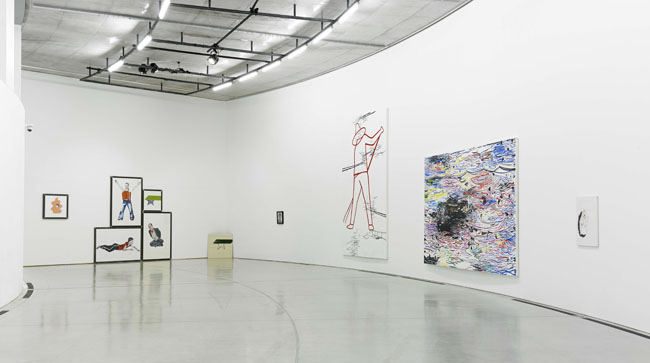
撮影:山本糾
行きつ、戻りつ: O JUNの「まんまんちゃん、あん」
近藤由紀
O JUNの絵画の多くには、人物や風景、日常的な事物――時にあまりに身近過ぎて違和さえ感じさせるような事物――が描かれている。描かれているモチーフはそれと判別できる時もあれば、角度や描き方によって抽象化された線や色の塊に見える時もある。肉付けや陰影のない平板な彩色や筆の動きやその痕跡が顕わな筆致、簡略化され記号化されたような図像や強い印象を与える画面の余白は、描かれた図像をその背景や文脈から切り離し、空中に放り投げているかのような印象を与える。描かれた図像は、それが何であるかを指示しようとすると、そのイメージと名前の間の、あるいはイメージと意味の間の互いに向かい合うまっすぐな線が、出会う直前でわずかにずらされ、その結合が回避されているように落ち着かない。そう感じさせるのは、形と線、図と色が同じ強さで眼前に交互に立ち現れることによって、描かれたイメージと物質としての絵の間を視線が揺れ動くからだけではなく、その図像自体が、偶然と必然の狭間で出現するイメージとして、図像に対する「意味」が発生する直前の事物として描かれているからではないだろうか。
本展はO JUNの2003年から2015年の間に制作された油彩画、本展のために制作された新作2点を含む近年のクレヨン画、そして2006年から継続的に制作されているガラス板と挟み鉄フレームに嵌められて展示される作品《遊園》のシリーズからの数点、そして手製の合金ペンで壁面に直描きされた滞在制作によるドローイングによって構成された。
展覧会タイトルの「まんまんちゃん、あん」は、関西方面で墓や仏像の面前や、食事の前など何かに「手を合わせる」際に子供が発する幼児語に由来するという。「南無阿弥陀仏」から転じたともされているが、作家はこれを子供の頃耳にした上方の漫才師の決め台詞として記憶していた。その言葉は意味も分からず記憶にとどまっていた音であり、意味が分からなかったからこそ、それを独自に解釈した個人的な記憶と結びついた未分類の、しかし鮮烈な言葉として残っていたのだろう。それが不意をついて出現した。
ある言葉あるいはイメージと記憶の奇妙な結びつきは、O JUNの作品においてしばしばみられる。O JUNに作品の背景や、描かれた図像のきっかけを聞いていると、偶然耳にした事件や目にした出来事、誰かが不意に発した言葉をきっかけに持つ作品がしばしば登場する。しかしその体験は、独自の解釈によって内在化され、本来の背景やさらには作家が付与した意味さえもそぎ落とされた形として抽出されている。展覧会のタイトルとなった漫才師の決め台詞として記憶されていたこの言葉もまた、作法を伴う行為に付随する言葉としてその本来の意味や語源を解体させながら日常生活に溶け込み、使われている言葉である。それはO JUNの作品におけるイメージの生成あるいは解体の過程を想起させる。こうした着地点をずらされ、放り出されているようにみえる図像だが、それは肩透かしとも違う。O JUNはインタビューの中で作品について、「構図とか構成を意識すると、たぶん絵はダメなんだろうなと思うんです。(中略)『描いてしまった』っていうことが、(中略)描かれた図なり像が宙ぶらりんになろうが、描かれてなんだか必死にその画面の中にへばりついている、そういう状態の方がまだいい」[1]と述べているが、それは構成や構図、ある種の約束事によって図像をそこに描くのではなく、記憶の結びつきや身体感覚などによって血肉化したイメージをある種の必然性によって捉えるということを意味しているのではないだろうか。制作の過程での偶然と必然によって結びついた出来事と作品における形は、着地点をずらされたイメージとして白い余白にくっきりと描かれている。
展覧会では、ギャラリー外側の壁面に様々な年代の油彩画が一直線に並べられた。それらは物語性や脈絡を持たずに配置されている。いや、もしかしたら作家の内には何らかの結びつきはあったのかもしれないが、それは表には現れていない。鉄フレームというある種同質の物質性をもって並置される《遊園》の展示と比べると、キャンバスに描かれた油彩画は、個別の質感をもち、個々の世界を完結させながら並置されている。その並置は、それぞれの画面の未到着の結末と、図像の緊張感がリズムとなり、完結した個別の作品世界同士の互いの関係性が奇妙な行間を生み出している。
それらが完成した作品の組み合わせによって生成される事態であるとすれば、内側壁面に描かれたドローイングはイメージ自体が生成する場として捉えられた。大きな壁面にパフォーマンスでしばしば使用される合金ペンで「落書きを基本として」描かれた線は、ある特定のイメージを描こうとして出てきたものではなかっただろう。落書きのように体を用いて描かれたぐにゃぐにゃとした曲線は、「うんこ」のような形になった。作家はこの線について、子供の頃の「顔がきれいだけれど、つまらない自慢話しかしない」ある種の両義性をもつ男児と彼が口にした「いろは坂」の記憶を結び付けた[2]。「うんこ」のような形には顔や手足がつき、最終的には本当に落書きのように様々な服装、様々な行為をしているうんこ頭の人々の群れが壁面に描かれた。ここでの主役はそのくねくねとした曲線とそこから派生する記憶やイメージが結びつくかつかないかのギリギリのところで作り出された一つの形なのであろう。ドローイングによって取り出された形は、最後にはうんこ頭を持つ肖像としてクレヨンによって「清書」され、鉄フレームに嵌められ《横顔 Profile》と題された。
ACACでの会期と重なって開催された東京のvoid+で行われたO JUNの展覧会では、クレヨンで描かれた作品が、鉄フレームがある状態とない状態の両方で展示されていた。鉄フレームに嵌められた作品は、完成したフレームによってそのイメージ自体の物質感がはく奪され、非物理的なイメージとしての強さを得る。一方額装されていないクレヨン画は、毛皮をはぎ取られた獣のように、紙やクレヨンといった現実にそれを構成する物質の存在感が顕わで、その対比はイメージが現実と虚構の間を行きつ、戻りつ揺れ動いているようにみえた。これに対しACACでのドローイングのうんこ頭と《横顔 Profile》からは、作家の手と内的作用によって起こるイメージの生成の過程を想像させた。
これらのドローイング作品は《糞世界》と題された。そして作品は会期半ばに開催されたワークショップにおいて、同じ手製の合金ペンを持った参加者たちのほとんど暴力的なほどに上書きされた「落書き」によって潰された。同じペンの使用は、O JUNの線と参加者の線の区別を難しくし、重ねられた線には優劣や高低といったヒエラルキーが失われていく。囲まれて図になった線を「絵」として特別視せず、体から生み出された衝動の痕跡のような線がすべての線を均質化していくようにみえたとき、O JUNが語った少年の両義性や排せつ物の平等性とともに、この作品のタイトルが別の意味を帯びてくる。衝動的な線の乱立は、直線的に並べられた絵画展示との比較において、描くことと、絵画であることの隔たりと近さを示した。そしてこれらの対比は描く行為の原初的な熱と描かれた虚構の世界がみせる新鮮な驚きを等価に表しているようでもあった。
[1] 2016年4月13日本展オープニング時のアーティスト・トークにおけるO JUNへの公開インタビュー(於ACAC)。
[2] O JUN「この糞世界」2016年(本カタログp.04~05)。
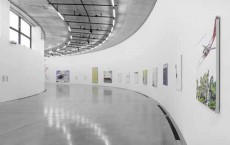

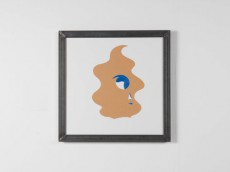
《横顔》
紙に色鉛筆、クレヨン、ガラス、鉄
75×75×5cm,2016年

《犬》
紙に色鉛筆、クレヨン、ガラス、鉄
75×75×5cm,2016年
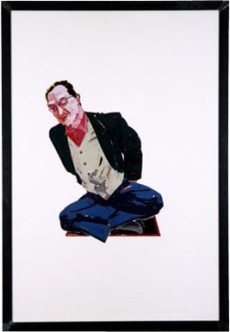
《カタルコ》
紙、顔料、ガッシュ、ガラス、鉄
171×119×5cm,2007年
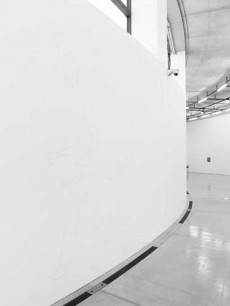
《糞世界》
壁面に手製合金ペン、2016年

